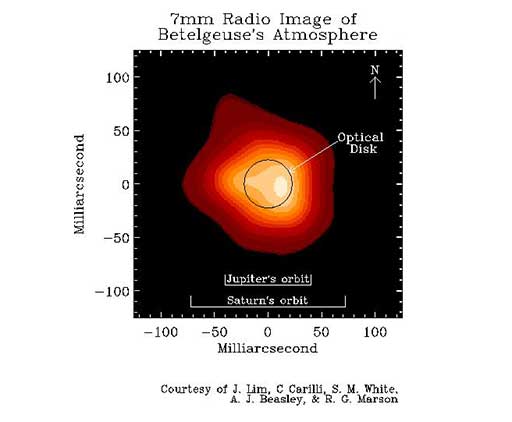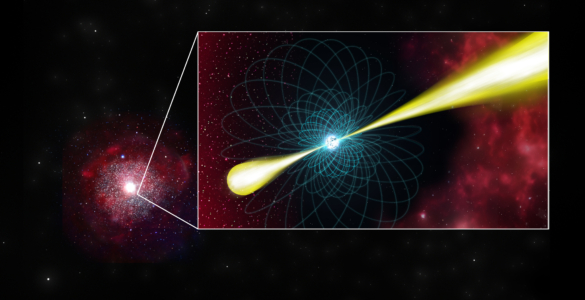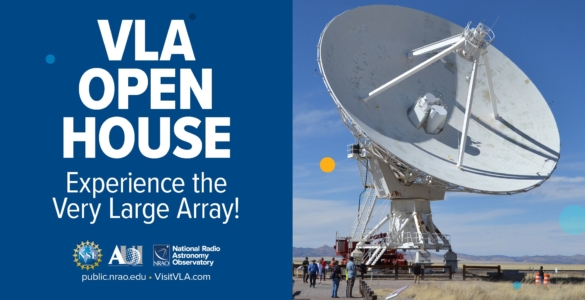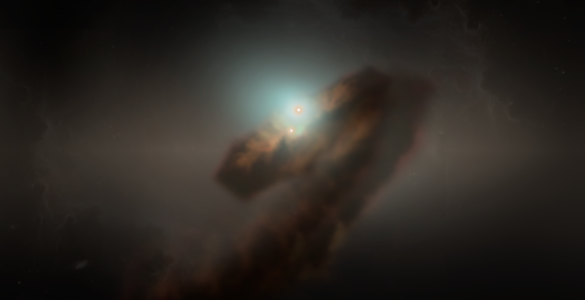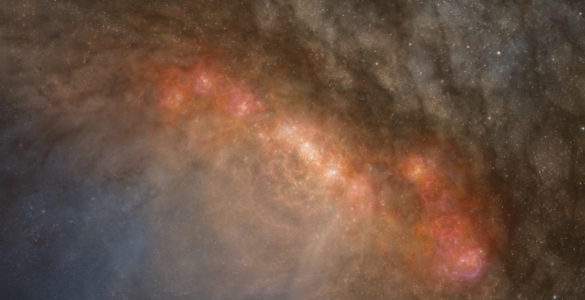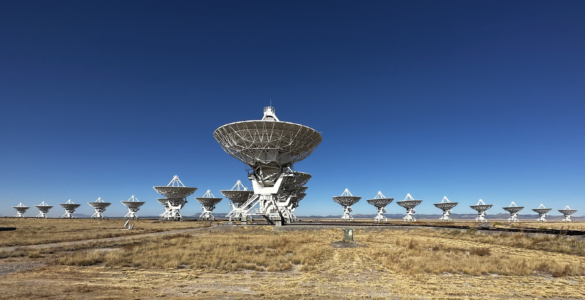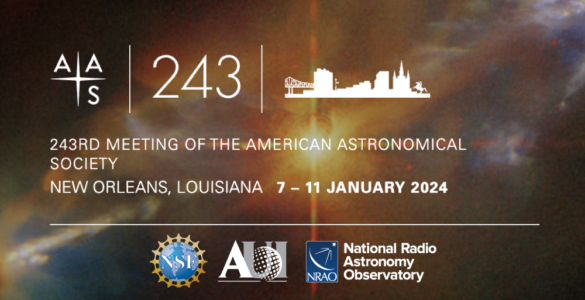A team of astronomers says that observations with the National Science Foundation’s Very Large Array (VLA) radio telescope show that a neighboring bloated star has giant convective plumes propelling gas from its surface (photosphere) up into the star’s atmosphere. This new information contradicts long-held ideas that such stellar atmospheres are more uniform, and may resolve questions about how the star’s atmosphere attains its enormous size as well as how dust and gas is driven away from the star.
Jeremy Lim of the Academia Sinica Institute of Astronomy & Astrophysics in Taiwan; Chris Carilli, Anthony Beasley, and Ralph Marson of the National Radio Astronomy Observatory (NRAO) in Socorro, NM; and Stephen White of the University of Maryland studied the red-supergiant star Betelgeuse, about 430 light-years away in the constellation Orion. They reported their findings in the April 9 issue of the scientific journal Nature.
“These radio-telescope images confirm that Betelgeuse — already more than 600 times larger than our Sun — has a dense atmosphere that extends to many times larger still than the star itself,” said Lim. “The highest-resolution image shows the star’s atmosphere to have a remarkably complex structure.” “To our surprise,” added White, “the images also show that most of the gas in the atmosphere is only about as hot as that on the surface. Previously, all of it was thought to be very much hotter.”
The astronomers used the VLA to make images of Betelgeuse at a variety of radio frequencies. The series of radio observations measured the temperature of the star’s atmosphere at different heights. Previous observations with the Hubble Space Telescope (HST) at ultraviolet wavelengths showed that the star’s atmosphere contains very hot gas at about twice the surface temperature. The VLA images showed that there also is lower-temperature gas throughout the atmosphere. This gas is near the surface temperature at low heights and decreases in temperature progressively outwards. Although its existence was not previously suspected, this lower-temperature gas turns out to be the most abundant constituent of Betelgeuse’s atmosphere.
“This alters our basic understanding of red-supergiant star atmospheres,” explains Lim. “Instead of the star’s atmosphere expanding uniformly because of gas heated to very high temperatures near its surface, it now appears that several giant convection cells propel gas from the star’s surface into its atmosphere. This creates the complex structure we observe for Betelgeuse’s atmosphere.”
Betelgeuse can be likened to an enormous “boiling” ball of gas heated by the release of energy from nuclear fusion in its core. The circulating boiling pattern — convection — appears as large regions of hot upwelling gas on the star’s surface. “The idea that red-supergiant stars have enormous convection cells is not new,” noted Marson. “This was suggested by Martin Schwarzschild more than 20 years ago, and was seen in optical images of Betelgeuse’s surface in 1990.”
The new picture of Betelgeuse’s atmosphere also helps resolve the mystery of how massive amounts of dust and gas are expelled from red supergiant stars, an important source of enrichment for the interstellar medium. If their atmospheres were entirely very hot at lower levels, dust grains would not be able to condense there. Dust grains could possibly condense at higher levels, but there they would not get enough “push” from the star’s radiation to explain their outward movement. In the new picture, the relatively cool environment at lower levels allows dust grains to condense effectively; here they can be strongly propelled by the more-intense starlight, carrying gas with them. Indeed, dust has previously been inferred to form sporadically near Betelgeuse’s surface, but its presence there was difficult to reconcile with the old picture.
“This method for propelling the mass outflows of red giant and supergiant stars was proposed by Sun Kwok in the same year that Martin Schwarzschild postulated the existence of large convection cells on these stars,” Lim said. “But it has taken us more than 20 years to realize their symbiotic relationship in structuring Betelgeuse’s atmosphere, and perhaps also the atmospheres of other such stars.”
“Just the fact that we can image the surface of a star other than the Sun blows me away,” said Carilli. “We used the highest frequencies available on the VLA, the largest spacing of VLA antennas, and new techniques for calibrating data to produce an image with extremely high resolution.”
The bright red star in the shoulder of Orion, the Hunter, Betelgeuse is a red supergiant about 10 times more massive than the Sun. In 1836, Sir John Herschel noticed that Betelgeuse, known since ancient times, actually changes its brightness. Astronomers now know that these regular brightness variations are caused by Betelgeuse’s rhythmic change in size over an approximately six-year cycle. If at the location of the Sun, Betelgeuse — one of the largest stars in our galaxy — would extend to the asteroid belt, swallowing Mercury, Venus, Earth, and Mars. The VLA measured the temperature of Betelgeuse’s atmosphere to a height beyond the orbit of Uranus, more than six times larger still than Betelgeuse itself.
The National Radio Astronomy Observatory is a facility of the National Science Foundation, operated under cooperative agreement by Associated Universities, Inc.
Contact:
Dave Finley, Public Information Officer
(505) 835-7302
dfinley@nrao.edu


